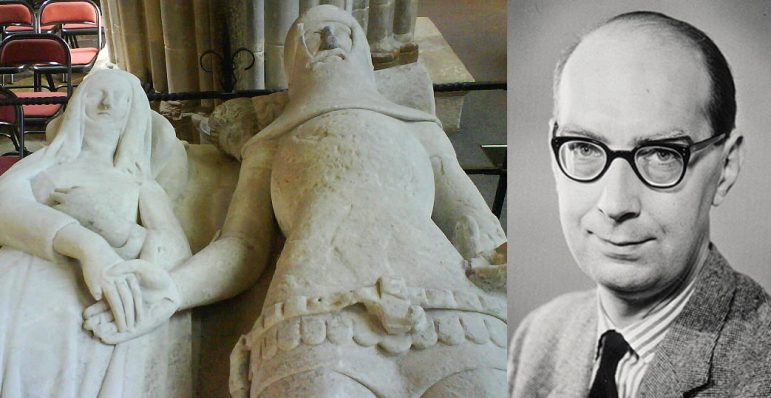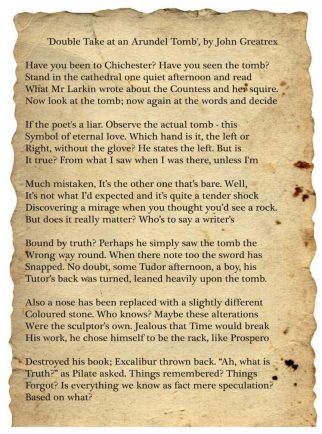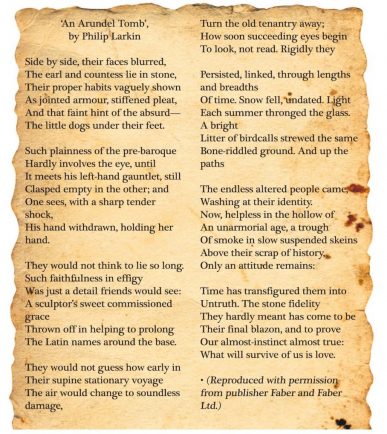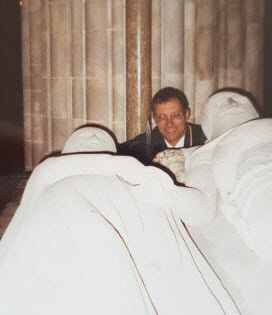A COVENTRY wordsmith who exchanged letters with Philip Larkin is calling on the city to place the world-renowned poet centrestage in the UK City of Culture 2021 celebrations.
Performing poet John Greatrex, a 70-year-old grandfather, moved to the city four years ago.
But his previously unknown relationship with the Coventry born giant of poetry goes back decades.
John, who now works in Sainsbury’s in Canley, once sent him his own poem – a ‘parody’ of Larkin’s ‘An Arundel Tomb’.
In the poem John pointed out some of the famous poem’s ‘mistakes’.
He was amazed when he got an unlikely private response – revealed here for the first time – which may be of interest to Larkin scholars and enthusiasts.
Larkin is hailed as one of the city’s most important figures.
He was born in Radford, Coventry, in 1922 until his family moved to Manor Road in Cheylesmore.
Despite being one of the country’s most recognised 20th century writers, he famously declined an OBE in 1968 and the chance to become the UK’s Poet Laureate in 1984.
But he did accept a Coventry Award of Merit – one of the city’s highest civil honours.
He has a plaque commemorating him at the city’s railway station.
Last year, a prominent city centre pub on the corner of the Burges and Corporation Street was re-named ‘The Phillip Larkin’.
He was also a symbol of Hull’s UK City of Culture 2017 celebrations, after spending many decades as a librarian at Hull University.
Coventry has sought to reclaim Larkin as its own, despite the poet speaking of the city in less than fond terms in some of his works.
In a poem called ‘I Remember, I Remember’ – daubed on the memorial plaque at the station – he hints at having the view he ‘wished the place in Hell’ and says Coventry was a place where his childhood was ‘unspent’.
In the poem Larkin is at the city’s station, reminiscing about his Coventry days.
John was previously a successful UK athlete, based in London, who competed in the Commonwealth Games.
John, now living in Allesley Green, said: “He is one of my favourite poets – an absolute inspiration to me.
“He is one of the key UK poets from the last century and we ought to be celebrating Larkin in the same way as other great figures in Coventry.
“He is as significant in poetry as George Eliot is in literature and he wrote some incredibly memorable lines.”
But a line which John took issue with was written in ‘An Arundel Tomb’.
Larkin wrote this poem in 1956 after a visit to Chichester Cathedral.
He was inspired by the tomb of fourteenth century figures Richard Fitz-Alan, the 10th Earl of Arundel, and his second wife, Eleanor of Lancaster.
The striking white sculpture is believed to have been carved around 1400.
And thanks to Larkin’s poem – in which he describes them holding hands on their deathbed – it has become a symbol of eternal love.
But John visited the cathedral in 1976 and noticed Larkin had not been entirely accurate in his famous poem.
He describes the earl’s ‘left-hand gauntlet’ being removed, to hold his wife’s hand.
But John noticed it is instead the right-hand, without a gauntlet, which is holding his wife’s.
And the earl’s nose has been replaced with a different colour stone.
These ‘alterations’ to the image provided by Larkin’s poem inspired John to write his own in response; ‘Double Take at an Arundel Tomb’.
The poem features the lines: “Stand in the cathedral one quiet afternoon and read what Mr Larkin wrote about the Countess and her squire.
“Now look at the tomb; now again at the words and decide if the poet’s a liar.”
John then ponders whether truth is a necessary duty of a poet and makes light of Larkin’s inaccuracy.
He sent a letter with his poem enclosed to Larkin in 1983. It said: “Dear Mr Larkin, please find enclosed a parody (if that’s really the right word) of a poem you wrote a number of years ago.
“I was in Chichester a while back and the enclosed bit of versification resulted from a number of visits to the Arundel Tomb.
“I hope you are not offended by it; it’s not really meant to be poking fun at anyone.
“It just seems that having written the thing, silly not to show it to you – since your original work was the spark causing me to write my little one.
“If what I’ve written causes you to smile, the hours of hard poetic graft will not have been in vain.”
By the time he had sent the letter, John had also learned that the previously separate tombs had been brought together in 1844 after being ‘drastically’ re-made – and was not part of the original sculptor’s intentions.
Larkin responded that same year. He said in a letter: “Dear Mr Greatrex, thank you for your poem.
“In my defence I should say that I looked at the tomb for perhaps two minutes in the late Fifties, and have never seen it since; however, it stayed in my memory and produced the poem I wrote.
“It is not surprising that I got the hands mixed up; I am more concerned to discover that the whole hand-holding business was a nineteenth century addition, and not the sculptor’s original conception.
“However, there were no postcards or articles available in those days; these have all appeared since I wrote the poem.”
John belongs to the Coventry Writers’ Group that meets monthly in The Big Cosy Cafe in Fargo Village and was the headline poet there at this September’s Fire and Dust Open Mic meeting where he read his Larkin Poem.
He is on the committees of Coventry Godiva Harriers and The Friends of London Road Cemetery.
‘An Arundel Tomb’, by Philip Larkin
Side by side, their faces blurred,
The earl and countess lie in stone,
Their proper habits vaguely shown
As jointed armour, stiffened pleat,
And that faint hint of the absurd—
The little dogs under their feet.
Such plainness of the pre-baroque
Hardly involves the eye, until
It meets his left-hand gauntlet, still
Clasped empty in the other; and
One sees, with a sharp tender shock,
His hand withdrawn, holding her hand.
They would not think to lie so long.
Such faithfulness in effigy
Was just a detail friends would see:
A sculptor’s sweet commissioned grace
Thrown off in helping to prolong
The Latin names around the base.
They would not guess how early in
Their supine stationary voyage
The air would change to soundless damage,
Turn the old tenantry away;
How soon succeeding eyes begin
To look, not read. Rigidly they
Persisted, linked, through lengths and breadths
Of time. Snow fell, undated. Light
Each summer thronged the glass. A bright
Litter of birdcalls strewed the same
Bone-riddled ground. And up the paths
The endless altered people came,
Washing at their identity.
Now, helpless in the hollow of
An unarmorial age, a trough
Of smoke in slow suspended skeins
Above their scrap of history,
Only an attitude remains:
Time has transfigured them into
Untruth. The stone fidelity
They hardly meant has come to be
Their final blazon, and to prove
Our almost-instinct almost true:
What will survive of us is love.
(Reproduced with permission from publisher Faber and Faber Ltd.)
‘Double Take at an Arundel Tomb’, by John Greatrex
Have you been to Chichester? Have you seen the tomb?
Stand in the cathedral one quiet afternoon and read
What Mr Larkin wrote about the Countess and her squire.
Now look at the tomb; now again at the words and decide
If the poet’s a liar. Observe the actual tomb – this
Symbol of eternal love. Which hand is it, the left or
Right, without the glove? He states the left. But is
It true? From what I saw when I was there, unless I’m
Much mistaken, It’s the other one that’s bare. Well,
It’s not what I’d expected and it’s quite a tender shock
Discovering a mirage when you thought you’d see a rock.
But does it really matter? Who’s to say a writer’s
Bound by truth? Perhaps he simply saw the tomb the
Wrong way round. When there note too the sword has
Snapped. No doubt, some Tudor afternoon, a boy, his
Tutor’s back was turned, leaned heavily upon the tomb.
Also a nose has been replaced with a slightly different
Coloured stone. Who knows? Maybe these alterations
Were the sculptor’s own. Jealous that Time would break
His work, he chose himself to be the rack, like Prospero
Destroyed his book; Excalibur thrown back. “Ah, what is
Truth?” as Pilate asked. Things remembered? Things
Forgot? Is everything we know as fact mere speculation?
Based on what?























